Boere vlags
|
FLAGS OF THE BOER REPUBLICS
|
|
|
|
SOUTH AFRICA • 1838 TO THE PRESENT
|
|
Notes
|
|
The course of southern Africa's history was profoundly affected by the establishment of a permanent settlement at the Cape of Good Hope by the Dutch East India Company (Vereenigde Oostindische Compagnie or VOC) in 1652. The Dutch were not interested in colonization; they wished merely to establish a way station on the spice route to the East Indies. At the Cape the VOC’s ships could shelter and replenish their supplies. In the course of time a number of company employees were released from their contracts to establish farms that could produce grain, vegetables, fruit and meat for the VOC settlement. From this handful of farmers sprang the “white tribe”—the Boers or Afrikaners of South Africa.
Besides the Dutch, the proto-Boer population was made up of some Germans, Scandinavians, and a few Huguenots fleeing from religious persecution in France. Gradually, the early Boers expanded into the southern African interior, establishing farms and villages as they advanced. At the Cape, where the VOC had begun to import slaves from Madagascar and Indonesia, many of the offspring of white and slave liaisons were also incorporated into the growing Boer population. The intermingling of the native population of the region, the Dutch and the imported slaves eventually produced South Africa’s Coloured population, as these people of mixed race are known today.
The expansion of the Cape Colony and the migrations of the Boers led inevitably to conflicts with the native peoples of the interior. Another source of friction was the annexation of the Cape Colony by Great Britain in 1806. As English-speaking whites poured into the colony, the Boers grew increasingly disaffected. Though British rule in fact perpetuated the white supremacy to which the Boers had grown accustomed, the 1834 abolition of slavery throughout the British Empire came as a shock. Soon thereafter began the epic of Boer history, the Great Trek and the Zulu wars. Beginning in 1836-37, some 12,000 Boers (the Voortrekkers or pioneers) set out on a great migration intended to carry them beyond British control. As fate would have it, the Great Trek coincided with Zulu expansion from the north, setting the stage of a series of conflicts that would lead to the creation of independent Boer republics, the rise of Boer nationalism, war with Britain and, eventually, the establishment of the Boer-dominated, apartheid Republic of South Africa that lasted until 1994.
|
|
THE DUTCH AT THE CAPE
|
|
| The flags of the Netherlands had a great influence on those later used by the Boers. Though by 1660 the orange-white-blue Princevlag (Prince's Flag) was beginning to give way to the red-white-blue Driekleur Vlag (Three-Color Flag), its memory influenced the design of the 1928 South African national flag. (Evidently, red replaced orange because the dyestuffs used to make Dutch flags in the late seventeenth century produced a color closer to red than orange.) Dutch maritime flags of the period were often made with the basic three-stripe pattern repeated, as in the example above (the tricolor pattern repeated twice, separated by a white stripe). Besides the plain Dutch tricolor, a variant with the monogram of the Dutch East Indies Company may also have been used at the Cape of Good Hope settlement. The small 'C" was for the Cape of Good Hope. | |
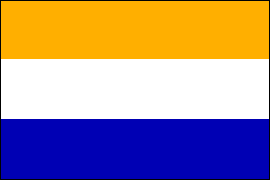 Princevlag
|
|
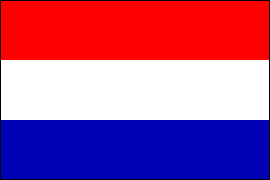 Driekleur Vlag
|
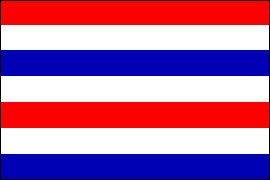 Driekleur Vlag • Variant
|
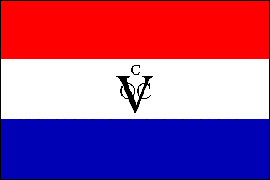 Vereenigde Oostindische Compagnie Vlag
|
|
|
VOORTREKKER SETTLEMENTS & BOER FREEBOOTER REPUBLICS
|
|
|
The Voortrekker Boers established a number of settlements and republics in the years following their migration out of the Cape Colony. The first flag that can be characterized as the banner of a Boer republic is the Voortrekker Vlag, blue with a red saltire cross. Also known as the Potgieter Vlag after General A.H. Potgieter, a leader of the migration, it is known to have been used from the early 1830s to about 1840, and in a slightly modified form it was the flag of Potchefstroom (founded 1838), the town that later became the first capital of the Zuid-Afrikaansche Republiek (South African Republic, also known as the Transvaal Republic). The Dutch colors (red, white and blue) figured in most of these flags. From the late 1830s to the 1880s, a spate of Boer mini-republics sprang into being. Some, like Natalia, were annexed by Britain; others. like the Klein Vrystaat (Little Free State) were eventually incorporated into the Zuid-Afrikaansche Republiek.
|
|
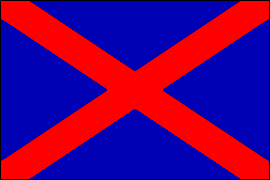
Voortrekker Vlag
|
|
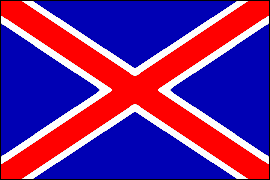 Potchefstroom • 1838-52
|
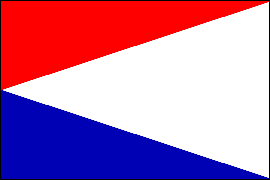 Natalia • 1838-43
|
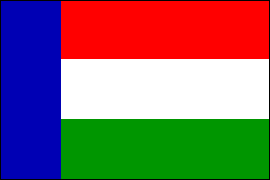 Nieuwe Republiek • 1881-84
|
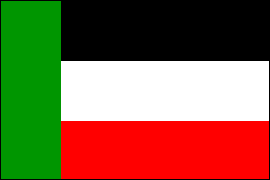 Goshen • 1884-85
|
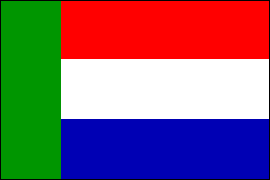 Klein Vrystaat • 1886-91
|
|
|
THE SOUTH AFRICAN REPUBLIC & THE ORANGE FREE STATE
|
|
|
When the Zuid-Afrikaansche Republiek (South African Republic) was formed in 1852 it had no official national flag, though probably the Voortrekker Vlag and its variant, the flag of the town of Potchefstroom, were in common use. Finally, in 1858, the Volksraad (Parliament) passed a law establishing a national flag. Designed by Reverend Dirk van der Hoff, it combined the horizontal red, white and blue stripes of the Dutch flag with a vertical green stripe at the hoist, thus symbolizing the Republic's African locale and its fraternal ties to the Netherlands. This flag, called the Vierkleur ("four colors") remained in use (with one brief intermission) until 1902, when defeat in the Anglo-Boer War brought an end to the Republic. In 1874, on the initiative of President Burgers, the old flag of Potchefstroom was made the national flag. Burgers disliked the Vierkleur and felt that the Potchefstroom flag, which was based on the Voortrekker Vlag, was a more appropriate banner for a Boer republic. Few people shared his opinion, however, and the Volksraad restored the Vierkleur in 1875—reportedly while President Burgers was absent on a visit to Europe! Perhaps as a sop to Burgers, the Potchefstroom flag was made the presidential flag. But it remained unpopular and soon fell into disuse.
|
|
 |
 |
|
Zuid-Afrikaansche Republiek • National Flags • 1858-1902
|
|
|
Like the South African Republic, the Oranje Vrijstaat (Orange Free State, established in 1854) at first had no official national flag. To remedy this situation, the Free State government petitioned King William III of the Netherlands for a grant of arms and a flag. The King agreed to this request and in 1856 his envoy arrived in the Free State's capital, Bloemfontein, to make the official presentation. The flag consisted of seven horizontal stripes, white and orange, with the Dutch flag as a canton. This design symbolized the Free State's name, its fraternal ties to the Netherlands, and the monarch of the House of Orange in whose name the flag was granted. It remained unchanged until 1902 when defeat in the Anglo-Boer War brought an end to the Free State.
|
|
Oranje Vrijstaat • National Flag • 1856-1902
|
|
|
THE ANGLO-BOER WAR
|
|
|
Though the Zuid-Afrikaansche Republiek and the Oranje Vrijstaat had not always enjoyed amicable relations, they made common cause against the British during the Anglo-Boer War (1898-1902). Their alliance was symbolically expressed by the various flags that were used by the Boer forces during the war. Most were variants of the Vierkleur Vlag with orange added, thus combining the colors of both Boer republics.
|
|
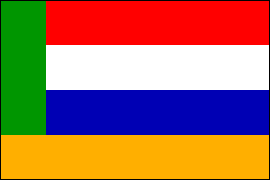 |
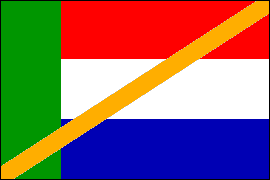 |
|
Boer "Unity" Flags • 1898-1902
|
|
|
APARTHEID SOUTH AFRICA
|
|
|
When the various British colonies in southern Africa were united in 1910 to form the Union of South Africa, its official national flag was the Union Jack and the de facto national flag was the South African Red Ensign. This situation did not suit the Boers and in 1928 South Africa adopted as its national flag a horizontal tricolor of orange, white and blue—a variant of the old Dutch Princevlag (Prince's Flag). On the white stripe was a badge combining the Union Jack and the flags of the former Boer republics. The design was in fact a compromise that did not entirely satisfy anyone. South Africans of British origin opposed the abandonment of the Union Jack, while the Boers wanted to expunge all reminders of the hated British connection. Though there were various proposals to replace it in later years the 1928 flag was not changed, even when South Africa became a republic in 1962. It was abolished in 1994 when the apartheid regime came to an end.
|
|
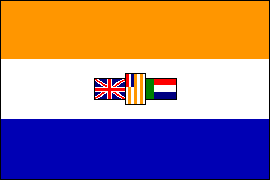
National Flag • 1928-94
|
|
|
THE BOERS IN POST-APARTHEID SOUTH AFRICA
|
|
|
With the end of the apartheid regime in 1994, the "white tribe" lost its dominant political and social position. This was reflected in the replacement of traditional national symbols, including flags and coats of arms, with new ones that did not recall the dark days of apartheid. The Boers, however, continue to display their traditional flags, particularly those of the former republics and variants thereof. A typical example of a variant flag is that of the Afrikaner Volksfront (Afrikaner People's Front), which is similar to the Vierkleur but with orange in place of red. Other contemporary Boer flags are frankly fascist in inspiration, such as those of the Boere Weerstandsbeweging (Boer Resistance Movement) and the Afrikaner Studentebond (Afrikaner Student Federation). Many of these Afrikaner political organizations advocate the creation of a separate homeland for the Boers.
|
|
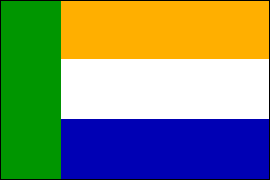
Afrikaner Volksfront
|
|
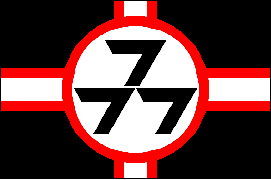 Boere Weerstandsbeweging
|
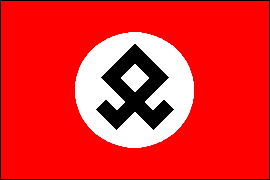 Afrikaner Studentebond
|
 |
||
|---|---|---|
 |
||
De Vlaamse Leeuw
|
||
Transvaalse VolksliedThe Transvaalse Volkslied, although the official anthem of the Zuid-Afrikaansche Republiek and when the territory was officially called Transvaal (1879-81and 1901 onwards), it was not well thought of by the authorities. The words and music of the Transvaalse Volkslied are by Catharina F van Rees, and it is dated 1875 - surprisingly it dates to the period before the annexation of 1879, since the emotions seem to blend well with those of the victorious rebels of 1881. Possibly this date accounts for the song's non-avoidance of the word Transvaal, which was the name of the state so strongly rejected in the uprising of 1880-81. The arrangement is by G G Cillie'. (There is an acute accent on the final letter in this surname; it is pronounced "Sil-yee". The surname is French, although its spelling is no longer authentically French; other members of this family spell it as Cilliers or Celliers.) The language is Dutch. (As mentioned previously, Afrikaans was the spoken language of all the 19th-century Boer republics, but was hardly ever written, and was not generally well thought of by |
||
VryheidsliedOn flipping through the FAK book I came across a song. The title is Vryheidslied. The lyrics are by Jan F E Celliers, and the music by Emiel Hullebroeck. The words are: |
||
Vaarwel aan die Vierkleur
|
||
Die Vlaglied / The Song of the FlagAnother flag song, this time abut the former South African flag called "Die Vlaglied" / "The Song of the Flag" which was composed by CJ Langenhoven, the composer of the former South African National Anthem "Die Stem van Suid-Afrika" / "The Call of South Africa". |
||
Die betekenis van 'n eie nasionale vlag word nêrens mooier en treffender besing as in die woorde van C.J. Langenhoven se Vlaglied nie. Die Vlaglied is slegs die laaste strofe van die gedig “Ons eie vlag”. Dit is deur F.J. Joubert getoonset. Nooit hoef jou kinders wat trou is te vra: Wat beteken jou vlag dan, Suid-Afrika? Ons weet hy's die seël van ons vryheid en reg Vir naaste en vreemde,vir oorman en kneg; Die pand van ons erf'nis,geslag op geslag, Om te hou vir ons kinders se kinders wat wag; Ons nasie se grondbrief van eiendomsland, Uitgegee op gesag van die Hoogste se hand. Oor ons hoof sal ons hys, in ons hart sal ons dra, Die vlag van ons eie Suid-Afrika. Which I translate as follows: THE FLAG SONG Nowhere the meaning of an own national flag is expressed more beautifully and fittingly than in the words of C.J. Langenhoven's Flag Song. This is the last stanza of the poem “Ons eie vlag” (Our own flag). It was set to music by F.J. Joubert. Never your children so faithful need ask: What does you flag mean then, South Africa? We know it's the seal of our freedom and rights For neighbour and stranger, for servant and boss; The pledge of our heritage, from parent to child To keep for our children's children to be The writ of our nation of the right to the land. That was written on authority of the Highest own hand We'll hoist ov'r our heads, and we'll hold in our heart The flag of our dearest South Africa Peter Hans van den Muijzenberg, 31 Aug 2007 |
||
The Fallen FlagWhile this is not a song about a flag (it has no tune that I am aware of), it is very much a poem about the vierkleur of the Zuid-Afrikaansche Republiek, and to my mind belongs with the South African flag songs which have already been posted to FOTW. This poem was published in England in 1902 as part of a collection entitled "Songs of the Veld". The book was banned in South Africa by the British |







